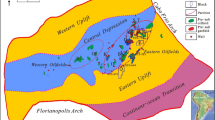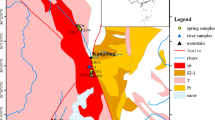Abstract
This study examines a particular phenomenon associated with a geothermal anomaly which is inconsistent with the basement structure of the Fushan Sag in Beibuwan Basin, China. The characteristics and forming mechanism of the geothermal anomaly are discussed based on geothermal data analyses and a paleo-geothermal simulation. The results indicated that the current value of geothermal flow in Fushan Sag is 86.4 mW m−2 on average. In contrast, the paleo-geothermal flow value is 77.7 mW m−2 on average. The current geothermal field of the Fushan Sag has higher temperatures than the paleo-geothermal field, and geothermal anomaly occurs in the current geothermal field. The basement structure, the typical anticline structure, the accumulation of hydrocarbons, and the deep magma chamber are the reasons for the geothermal anomaly. The geothermal anomaly has been linked to deep magma body, which is located in depth of 15 km near the Bailian district. The formation of the geothermal anomaly occurred 10,000 years ago and was relatively short, having little effect on the maturity of organic matter. However, a large number of paleo-oil reservoirs were thermally pyrolyzed into condensate gas reservoirs at the center of the abnormal geothermal area, which had a significant effect on paleo-oil reservoir in the Fushan Sag.







Similar content being viewed by others
References
Barker CE (1983) Influence of time on metamorphism of sedimentary organic matter in liquid- dominated geothermal systems, western North America. Geology 11(7):384–388
Brigaud F, Chapman DS, Douaran SL (1990) Estimating thermal conductivity in sedimentary basins using lithologic data and geophysical well logs. AAPG Bull 74(9):1459–1477
Brigaud F, Vasseur G, Gaillet G (1992) Thermal state in the North Viking Graben (North Sea) determined from oil exploration well data. Geophysics 57(1):69–88
Chen MX, Wang JY, Wang JA, Deng X, Yang SX, Xiong LP (1990) The characteristics of the geothermal field and its formation mechanism in the north China down-faulted basin. Acta Geologica Sinica 64(l):239–252
Chen SB, Gan HJ, Shi Y, Zhao YD, Wang X (2015) Geochemical features and geologic significance of source rocks in Fushan Sag, Beibuwan basin. Petroleum Geology and Recovery Efficiency 22(1):14–19,25 (in Chinese with English abstract)
Demongodin L, Pinotean B, Vasseur R, Gable R (1991) Thermal and conductivity and well logs- a case study in the Paris Basin. Geophys J Int 105(3):675–691
Fan QC, Sun Q, Li N, Sui JL (2004) Periods of volcanic activity and magma evolution of Holocene in north Hainan Island, Acta Petrologica Sinica. 20(3):533–544
Gao FL, Yang XQ, Wu GA, Fu YR, Chen YW (2009) Characteristics of thermal springs and genesis of thermal underground waters in Hainan Island. Journal of Jilin University: Earth Science Edition 39(2):281–287 (in Chinese with English abstract)
Goutorbe B, Lucazeau F, Alain B (2006) Using Neural Networks to predict thermal conductivity from geophysical well logs. Geophys J Int 166(1):115–125
Hu JS (1989) Abnormal pressure, fluid fracturing and migration of oil and gas. Petrol Explor Dev+ 16(2):16–22
Hu SB, Wang JY (1995) Principles and progresses on thermal regime of sedimentary basins an overview. Earth Science Frontiers 2(3-4):171–180 (in Chinese with English abstract)
Hu SB, He LJ, Wang JY (2001) Compilation of heat flow data in the China continental area (3rd edition). Chinese J Geophys-Ch 44(5):611–626
Hunt JM (1979) Petroleum geochemistry and geology. Freeman W H, San Francisco
Kang XD, Li ST, Li YL, Hu ZL (1995) Study on the geothermal characteristics and thermal history of Beibuwan Basin. Journal of Changchun University of Earth Sciences 25(2):173–177 (in Chinese with English abstract)
Li MJ, Wang TG, Liu J, Zhang MZ, Lu H, Ma QL (2007) Genesis and source of natural gas in the Fushan depression, Beibuwan Basin. Natural Gas Geoscience 18(2):260–265 (in Chinese with English abstract)
Li CR, Zhang GC, Liang JS, Zhao ZG, Xu JY (2012) Characteristics of fault structure and its control on hydrocarbons in the Beibuwan Basin. Acta Pet Sin 33(2):195–203
Liu H, Hong HJ, Ran HL, Shen FL, Zhao B, Chen HX (2008) Dynamic mechanism of volcanic belt and new understanding from earthquake evidence in Northern Hainan Island, China. Chinese. J Geophys 51(6):1804–1809
Liu Y, Hu DG, Xu SF, Li ZL, Chen C (2019) Electrical anisotropic structure in the quaternary volcanic region of north Hainan Island and its geological implication. Earth Sci 44(4):387–393
Molnar PS, Hodge D (1982) Correlation of thermal conductivity with physical properties obtained from geophysical well logs. AAPG Bull 66(5):608–609
Nielsen SB, Clausen OR, Mc Gregon E (2017) Basin % Ro: a vitrinite reflectance model derived from basin and laboratory data. Basin Res 29(Suppl.1):515–536
Ren ZL, Zhang S, Gao SL, Cui JP, Xiao YY, Xiao H (2007) Tectonic thermal history and its significance on the formation of oil and gas accumulation and mineral deposit in Ordos Basin. Sci China Ser D Earth Sci 50(supplement):23–32
Stocchetti N, Picetti E, Berardino M (2011) Experimental determination of electrical conductivity during deformation of melt–bearing olivine aggregates: implications for electrical anisotropy in the oceanic low velocity zone. Earth Planet Sci Lett 302(1-2):81–94
Sun Q (2003) Quaternary volcanic activity and magma evolution in north Hainan Island. Institute of Geology,China Seismological Bureau, Beijing
Sweeney JJ, Burnham AK (1990) Evaluation of a simple model of vitrinite reflectance based on chemical kinetics. AAPG Bull 74(10):1559–1570
Vacquicr V, Mathieu Y, Legendre E, Blondin E (1988) Experiment on estimating thermal conductivity of sedimentary rocks from oil well logs. AAPG Bull 72(6):758–764
Wang LS, Shi YS (1989) Geothermal study on the oil and gas basin. Nanjing University Press, Nanjing, pp 20–42
Wang LS, Li C, Liu SW (2003) Geotemperature gradient distribution of Kuqa foreland basin, north of Tarim, China. Chinese J Geophys 46(3):403–407
Wang H, Liao YT, Lin ZL (2011). Paleogene study of the tectonic geomorphology, sequence stratigraphy and sedimentary evolution in Fushan Sag, Beibuwan Basin. Wuhan:China University of Geosciences(Wuhan)
Woodbury AD, Smith L (1985) On the thermal effects of three-dimensional ground water flow. J Geophys Res 90(B1):759–767
Xie MQ (1981) The controlling role of terrestrial heat flow in the genesis of petroleum. Acta Petrolei Sinica 2(1):41–48
Xiong LP, Zhang JM (1988) Relationship between geothermal gradient and the relief of basement rock in North China plain. Acta Geophysica Sinica 31(2):146–155
Xiong LP, Hu SB, Wang J (1994) Analysis on the thermal conductivity of rocks from SE China. Acta Petrol Sin 10(3):323–329
Xu ZY, Yu G, Wu WQ, Ma QL, Huang L (2014) Structural featuresand controlling on oils in southeastern Beibu Gulf Basin. Petroleum Geology & Experiment 36(2):144–152 (in Chinese with English abstract)
Zhang HF (1999) Petroleum geology. Petroleum Industry Press, Beijing
Zhang J, Song HB (2001) The thermal structure of main sedimentary basins in the northern margin of the South China Sea. Jounal of Geomechanics 7(3):238–244 (in Chinese with English abstract)
Acknowledgements
This work was supported by the National Natural Science Foundation of China (NO. 41461021 and NO. 41661085).
Author information
Authors and Affiliations
Corresponding author
Additional information
Responsible Editor: Santanu Banerjee
Rights and permissions
About this article
Cite this article
Zhao, Y., Bai, K. & Zhao, Y. Characteristics of a geothermal anomaly in the Fushan Sag, Beibuwan Basin, China, and its effects on oil and gas reservoirs . Arab J Geosci 12, 698 (2019). https://doi.org/10.1007/s12517-019-4889-8
Received:
Accepted:
Published:
DOI: https://doi.org/10.1007/s12517-019-4889-8




